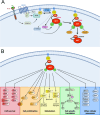AKT kinases as therapeutic targets
- PMID: 39614261
- PMCID: PMC11606119
- DOI: 10.1186/s13046-024-03207-4
AKT kinases as therapeutic targets
Abstract
AKT, or protein kinase B, is a central node of the PI3K signaling pathway that is pivotal for a range of normal cellular physiologies that also underlie several pathological conditions, including inflammatory and autoimmune diseases, overgrowth syndromes, and neoplastic transformation. These pathologies, notably cancer, arise if either the activity of AKT or its positive or negative upstream or downstream regulators or effectors goes unchecked, superimposed on by its intersection with a slew of other pathways. Targeting the PI3K/AKT pathway is, therefore, a prudent countermeasure. AKT inhibitors have been tested in many clinical trials, primarily in combination with other drugs. While some have recently garnered attention for their favorable profile, concern over resistance and off-target effects have continued to hinder their widespread adoption in the clinic, mandating a discussion on alternative modes of targeting. In this review, we discuss isoform-centric targeting that may be more effective and less toxic than traditional pan-AKT inhibitors and its significance for disease prevention and treatment, including immunotherapy. We also touch on the emerging mutant- or allele-selective covalent allosteric AKT inhibitors (CAAIs), as well as indirect, novel AKT-targeting approaches, and end with a briefing on the ongoing quest for more reliable biomarkers predicting sensitivity and response to AKT inhibitors, and their current state of affairs.
Keywords: AKT kinases; Cancer; Inflammation; Overgrowth syndromes; Therapy.
© 2024. The Author(s).
Conflict of interest statement
Declarations. Ethics approval and consent to participate: Not applicable. Competing interests: The authors declare no potential conflicts of interest related to this work.
Figures



References
-
- Staal SP. Molecular cloning of the akt oncogene and its human homologues AKT1 and AKT2: amplification of AKT1 in a primary human gastric adenocarcinoma. Proc Natl Acad Sci U S A. 1987;84:5034–7. https://www.ncbi.nlm.nih.gov/pubmed/3037531. - PMC - PubMed
-
- Bellacosa A, Testa JR, Staal SP, Tsichlis PN. A retroviral oncogene, akt, encoding a serine-threonine kinase containing an SH2-like region. Science. 1991;254:274–7. https://www.ncbi.nlm.nih.gov/pubmed/1833819. - PubMed
-
- Coffer PJ, Woodgett JR. Molecular cloning and characterisation of a novel putative protein-serine kinase related to the cAMP-dependent and protein kinase C families. Eur J Biochem. 1991;201:475–81. https://www.ncbi.nlm.nih.gov/pubmed/1718748. - PubMed
-
- Jones PF, Jakubowicz T, Pitossi FJ, Maurer F, Hemmings BA. Molecular cloning and identification of a serine/threonine protein kinase of the second-messenger subfamily. Proc Natl Acad Sci U S A. 1991;88:4171–5. https://www.ncbi.nlm.nih.gov/pubmed/1851997. - PMC - PubMed
-
- Ahmed NN, Franke TF, Bellacosa A, Datta K, Gonzalez-Portal ME, Taguchi T, et al. The proteins encoded by c-akt and v-akt differ in post-translational modification, subcellular localization and oncogenic potential. Oncogene. 1993;8:1957–63. https://www.ncbi.nlm.nih.gov/pubmed/8510938. - PubMed
Publication types
MeSH terms
Substances
LinkOut - more resources
Full Text Sources

